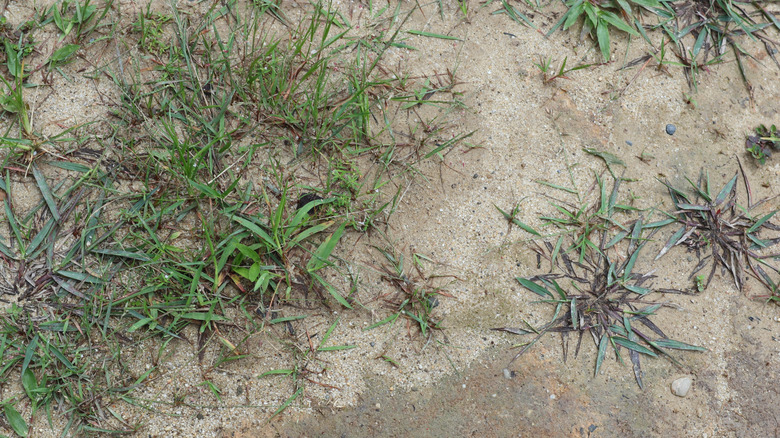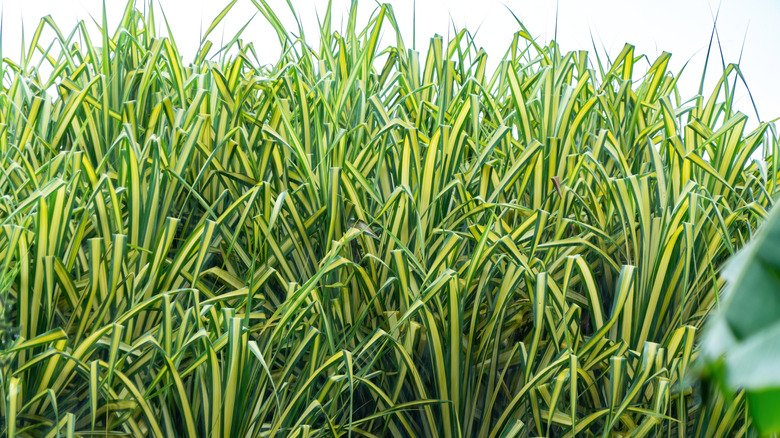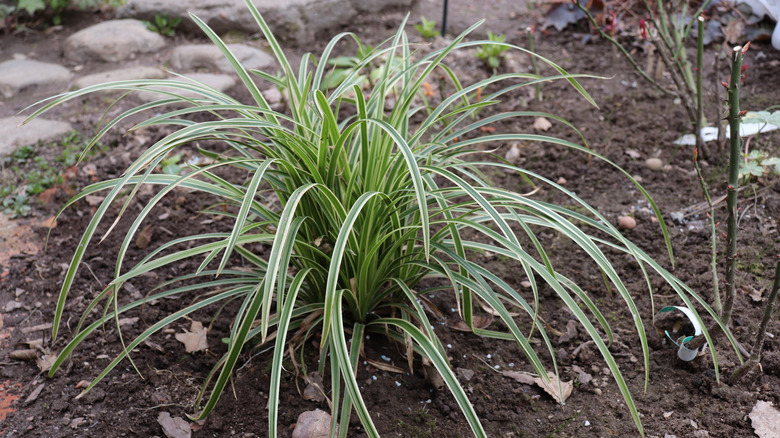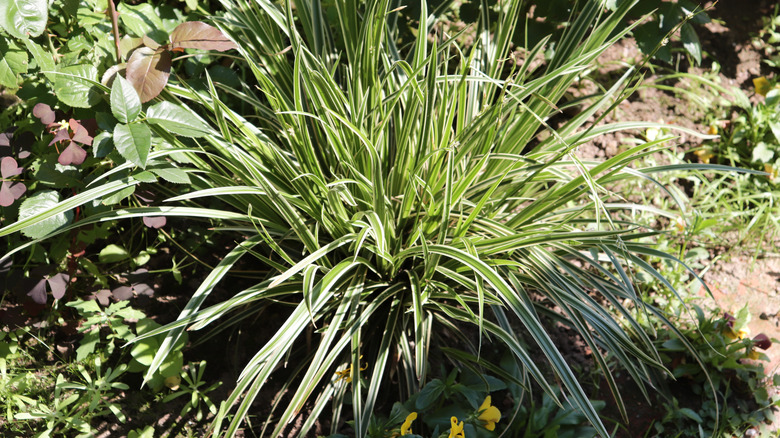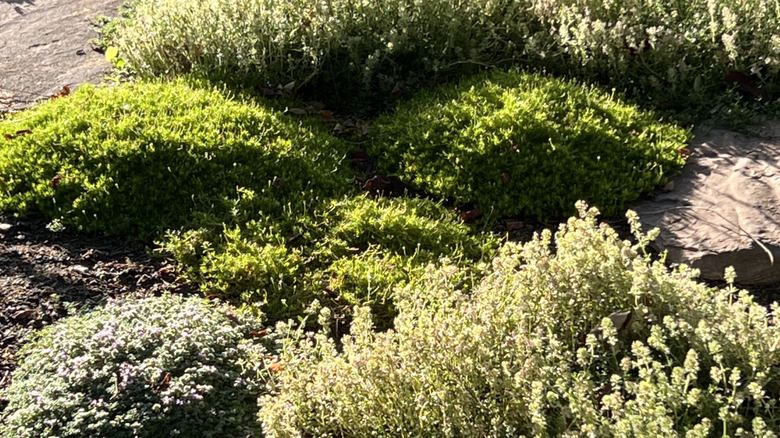Prevent Soil Erosion And Suppress Weeds With This Alluring Evergreen
Whether you're gardening on a slope or dealing with out-of-control weeds, maintaining an attractive garden can feel impossible. One of the best ways to reclaim your yard is with plants. However, the key to successfully controlling both erosion and weeds is to choose the right plant for the space. One of the best ground covers great for preventing soil erosion is Ice Dance Carex (Carex morrowii 'Ice Dance').
According to Lorin Nielsen, Head Horticulturist and Senior Botanical Editor of Epic Gardening, "'Ice Dance' and other Carex morrowii varieties tend to be lovely, semi-upright ground cover plants that can slow soil erosion." It's especially ideal for wet or shady areas where your existing grass might be struggling to grow. "It's very tolerant of wet or boggy areas in the garden," Nielsen noted in an exclusive interview with House Digest. While the horticulturist said that the evergreen sedge is slow to spread, it forms a dense mat that stays in place through the winter to provide year-round weed suppression and erosion control.
Once established, there's not much you need to do to keep it thriving. "'Ice Dance' and other Carex morrowii varieties are easy-care plants, falling into the category of 'set it and forget it' ground covers," said Nielsen. If you've got a soggy area where grass won't grow but weeds seem to be thriving, Carex morrowii varieties like 'Ice Dance' might be just the thing. Just make sure it's planted somewhere it can get plenty of moisture and won't be exposed to full sun.
How 'Ice Dance' helps with erosion and weeds
'Ice Dance' is a sedge that spreads slowly by rhizomes, which is what makes it such an effective plant for controlling both erosion and weeds. In an exclusive interview with House Digest, Lorin Nielsen explained, "As your sedge puts out rhizomes, it gradually widens to create a dense cover of root tissue that reduces competition from weeds by simply choking them out and taking up the nutrients or moisture the competing weeds need to survive."
So, the seed bank already in your soil will be choked out by the 'Ice Dance,' but this pretty Japanese sedge can also keep new weed seeds that land in the area from germinating. "The dense spread of the underground rhizomes makes putting down roots trickier for herbaceous weed species," said Nielsen.
Rhizomatous species like this sedge are also some of the most effective choices for preventing erosion. The dense matrix of roots growing along the surface and deeper into the soil helps hold the soil in place. At the same time, the top growth helps intercept rain, slowing the force of raindrops and water runoff so that it can penetrate the soil rather than wash it away.
While many rhizome-spreading species can be aggressive growers, 'Ice Dance' is one of the few that are unlikely to grow uncontrollably. According to Nielsen, "Japanese sedges like 'Ice Dance' tend to be fairly slow to spread." This means you can enjoy all the benefits of a rhizomatous ground cover without worrying that it will take over your entire yard.
Tips for planting and maintaining 'Ice Dance' in your yard
Hardy in zones 5 through 9, this Japanese sedge will do best if planted in consistently moist soil in the shadiest parts of your yard. Whether your goal is erosion control or weed suppression, plant your 'Ice Dance' plugs closely together so that they can fill the area faster. In general, to create a dense planting, the distance between plugs should be about half the mature height of the plant. Since the sedge typically only grows to 1 or 2 feet tall, you could space plugs anywhere from 6 to 12 inches apart.
As far as timing your planting, that depends on where you are. In the exclusive interview with House Digest, Lorin Nielsen said, "Most zone 9 growers may find a fall planting performs better as it takes advantage of the cool season to become established." On the other hand, spring planting is better for gardeners in the colder parts of the plant's range. "Those in zone 5 will probably want to allow it a full season of becoming established before it experiences its first truly-cold winter," Nielsen added.
The horticulturalist also recommended mulching around the plants to keep the soil moist. According to Nielsen, "This slows down soil moisture evaporation enough to reduce the watering frequency." Otherwise, you may need to water regularly if you don't have a consistently moist area in your yard to plant it.
The downsides to 'Ice Dance'
While the rhizome-spreading 'Ice Dance' makes an excellent ground cover for stopping erosion and suppressing weeds, it's not a perfect solution. One of the biggest downsides Lorin Nielsen noted in the exclusive House Digest interview is its slow growth. "When first planted, it hasn't had the time to stretch out its rhizomes and start forming that dense mat of root tissue," Nielsen explained in an exclusive interview with House Digest.
Even with closing spacing, it can take some time for the sedge to fully cover the soil to provide maximum protection from weeds and erosion. In the meantime, you'll need to keep weeding the area yourself while you wait for it to fill in. According to Nielsen, "Staying on top of the weeding around your C. morrowii is recommended after you plant to ensure it doesn't have competition as it settles in."
She also noted that the Japanese sedge might not be as effective at suppressing other rhizomatous species. "Many weedy plants also have rhizomatic growth but have a faster growth habit than 'Ice Dance' carex does, particularly rhizomatic grasses like Bermuda grass, and those can still be problematic," Nielsen said. The sedge may be great at stopping weed seeds from germinating. But you might still find yourself ripping up Bermuda grass and similar weeds that manage to continue spreading through the area. With that said, it's a great ground cover to smother weeds in your yard if the area you're trying to control is too shady for grass or your other favorite ground covers.
Alternatives to 'Ice Dance' for dry or sunny yards
As effective as 'Ice Dance' can be, it's of little use to gardeners with sunny, dry yards. This sedge needs consistently moist soil and even thrives in wet soil. It's also best suited to shady spots, preferring deep shade over full sun. Fortunately, the sedge is just one of many plants that'll help prevent pesky weeds in the garden.
If you don't have the moist, shady conditions the Japanese sedge prefers, there are other options that might be a better fit. "Any plant that shades the soil underneath it will prevent most sun-loving weeds from coming up simply by blocking their exposure to the light above," Lorin Nielsen told House Digest in an exclusive interview.
The horticulturalist recommended creeping varieties of rosemary or thyme for gardeners in arid environments. These woody herbs form a similarly dense mat of ground cover, but thrive in sunny, dry conditions better than the Japanese sedge does. If you want something less woody, she recommends sweet woodruff, a spreading perennial with grass-like leaves and small, charming flowers in spring.
The bottom line is that any plant is better than bare soil when it comes to preventing erosion or keeping weeds at bay. "Just by ensuring you keep your space filled and that there aren't bare patches of soil waiting to have wild seeds land and germinate in them, you can reduce the incidence of weeds spreading in your garden," said Nielsen.
